This page is written for those who are new to the world of Mini Jerseys.
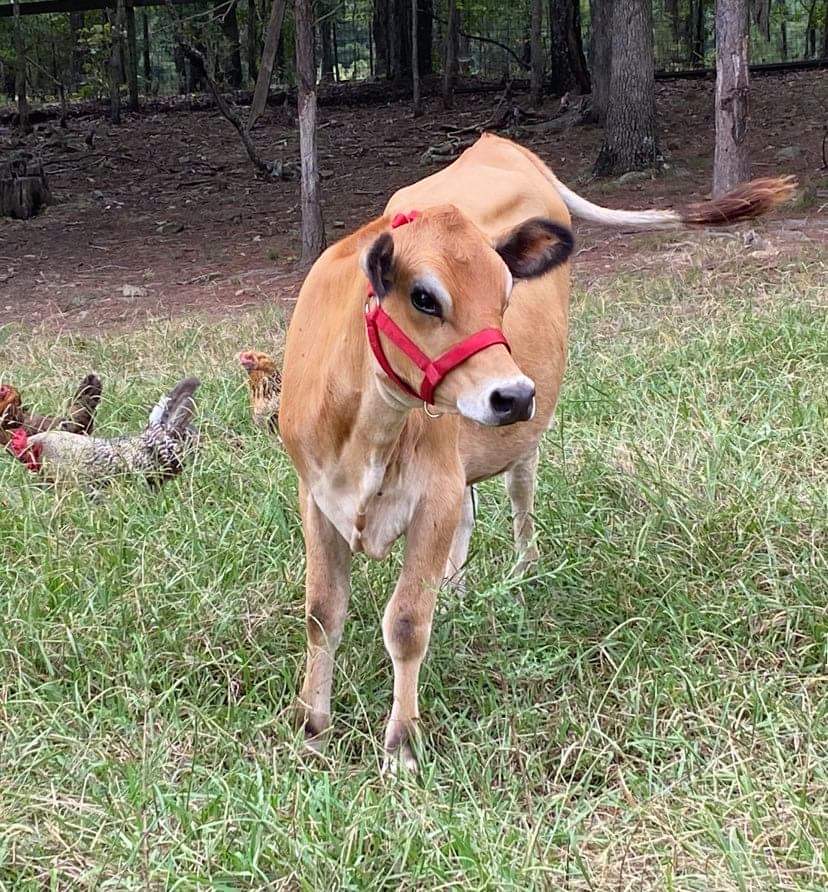
As a recent newbie ourselves, we wish there had been a page like this to guide us as we purchased our first cow. If you want good stock and are new to cattle, the first purchase can be a confusing at best. At worst, you can be cheated by sellers who misrepresent, lie, or pawn off inferior stock on unsavvy newbies. Hopefully this information will help.
Why is a first-time cattle purchase typically confusing?
Well, first, there’s a lot of terminology that might confuse you. The technical terms sometimes have similar names and it can be hard to sift through them.
In addition, not all organizations connected with miniature cattle use the same definitions (for example, different registries — there are four of them — use differing height cutoffs, which are measured differently).
And, you will get varying opinions on the importance of various aspects of cows themselves (milk elements, purity of bloodlines for example). Those with cows who, for instance, give A1 milk will downplay this aspect of their cow when they know that the market is demanding A2 milk now and in the future. (Read more below on A1 and A2 milk.)
I’ve tried to fairly represent two sides to issues that remain contentious. I have no ax to grind, and no fingers to point, except to say that in this market, the buyer needs to be extremely wary and also patient. You will probably not find your quality cow quickly; nor will she be cheap! I pray that this page helps newcomers to be informed, so they can make the best decisions for them.
So, here’s a good-faith attempt to clarify some things, and give some advice.
It’s a long page, so we have added bookmark links that allow you to jump to the topic that most interests you.
About Size Distinctions and Terminology
About Registries and Registrations
Questions to Ask When Buying a Miniature Jersey
About Size Distinctions and Terminology
The diagram below shows the height breakdowns of cattle as generally accepted. (There are four Mini Jersey registries; they don’t all have the same height restrictions between mini and midi animals.) These measurements are taken and the rear hip (at differing locations for differing registries) not at the withers, as with other livestock.
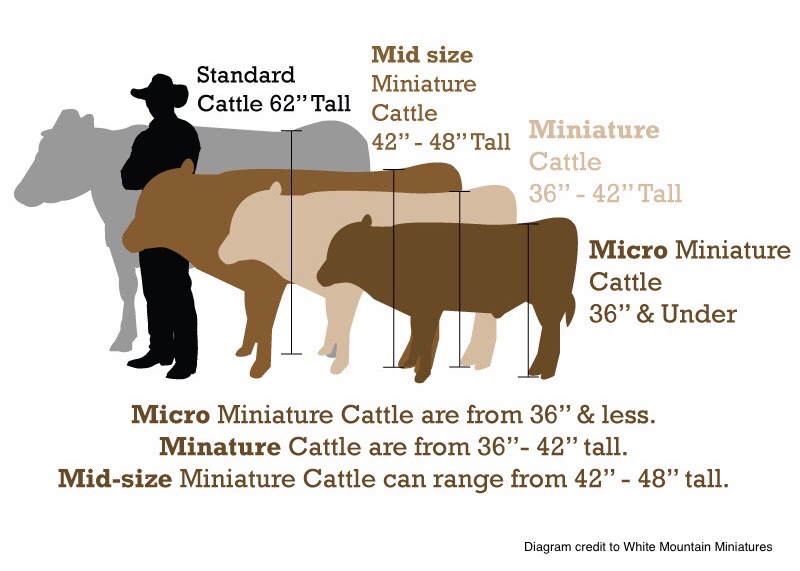
Generally speaking…
- Small is beautiful to many buyers, and the lower the height, the more expensive the animal will be, all else being equal. It takes years and years of selective breeding to get to the mini or micro levels. Expect to pay between $8K-$10K for a purebred (note this term; it’s defined in important detail below) A2/A2, polled cow or heifer. Bulls are less, usually.
- Small is nice for many reasons: less feed, less pasture (or, the ability to fit more of them onto your pasture), smaller housing, easier to manage around children or elderly attendants.
- Miniature Jerseys give less milk per day than their standard counterparts. Average milk amounts vary (and depend on whether the cow is also sharing milk with a calf). The range is wide: somewhere between 1.5 and 3 gallons twice a day, without sharing with a calf.
- Shorter cows may be harder to milk; their teats will be much closer to the ground than their taller counterparts. This is going to be even more important if you’re planning to use a milking machine.
About Milk-Related Terms
Below is pictured a result from test results for our first cow, registered name of Emma. You can see pictured detailed explanations of what the test results mean to the testers. Below, I’ll explain what they mean to cow buyers/sellers.
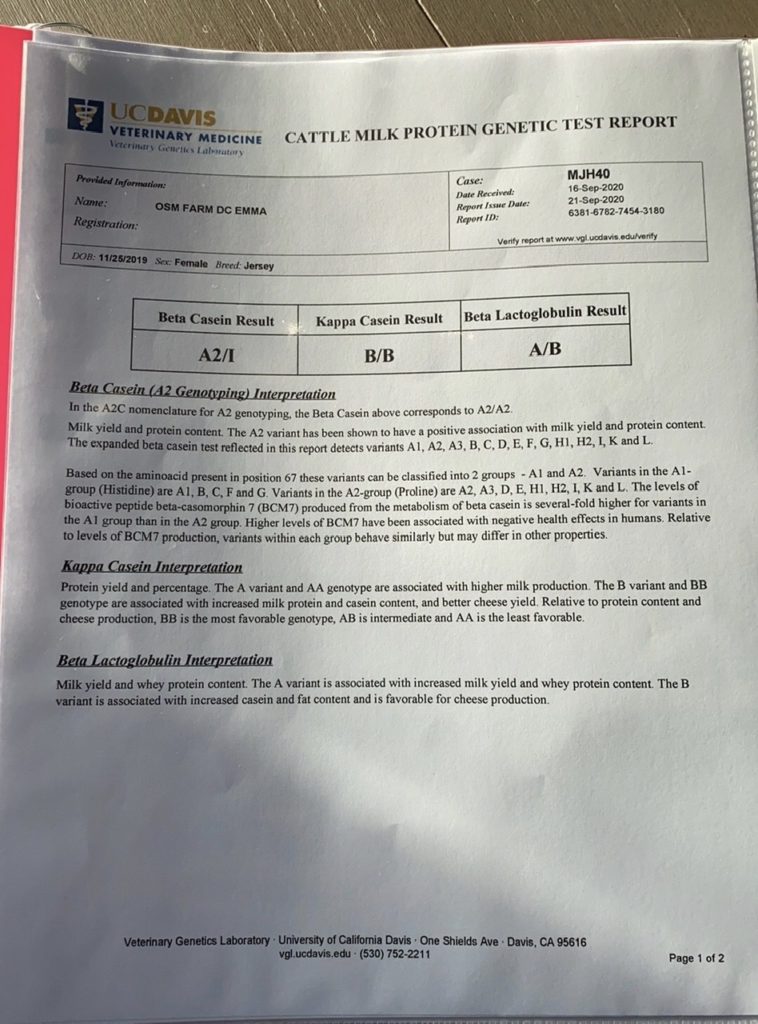
So, Emma is considered an A2/A2: homozygous for A2 milk (the “I” being a variant of A2, as you can read in the report at the left). All of her offspring will have A2 beta casein milk, if bred by an A2/A2 bull.
What does that mean to the buyer/seller of a cow? In the most BASIC terms, it means that many people who cannot digest/tolerate A1 milk (which is what is mostly available in American supermarkets), and think that they may be lactose intolerant are actually sensitive to microscopic elements in A1 beta caseins, but can tolerate just fine A2 milk.
This is one of the commonly debated topics in the Mini Jersey world. Those who have been around the longest downplay the importance of the A1/A2 distinction… but most of their older bulls are A1s. However, the future belongs to A2 cows; the entire dairy industry is moving to A2 cows.
If you want to read about this in depth from a neutral source, I’ve excerpted a lengthy passage from Keeping A Family Cow, by Joann S. Grohman. See it HERE along with other references to scientific studies. Just for interest’s sake, all goat milk is also A2.
Kappa Casein: The information below was retrieved from https://vgl.ucdavis.edu/test/kappa-casein
The gene underlying the production of kappa-casein in cow’s milk shows polymorphisms which affect the amount of protein produced. Higher levels of kappa-casein are associated with increased milk protein and casein content, and better cheese yield.
A = associated with lower relative concentration of kappa-casein in milk
B = associated with higher relative concentration of kappa-casein in milk
Cows with AA genotype will produce lower amounts of kappa-casein in their milk; least favorable genotype for cheese production.
Cows with AB genotype will produce intermediate amounts of kappa-casein in their milk.
Cows with BB genotype will produce higher amounts of kappa-casein in their milk; most favorable genotype for cheese production.
Beta Lactoglobulin: the information below was retrieved from https://vgl.ucdavis.edu/test/beta-lactoglobulin
The gene underlying the production of beta-lactoglobulin protein in cow’s milk shows polymorphisms which affect the amount of protein produced. Higher levels of beta-lactoglobulin are associated with increased milk yield and whey protein content, and low levels are associated with increased casein and fat content and are favorable for cheese production.
A = associated with higher relative content of beta-lactoglobulin
B = associated with lower relative content of beta-lactoglobulin
Cows with A/A genotype will produce higher amounts of beta-lactoglobulin.
Cows with A/B genotype will produce intermediate amounts of beta-lactoglobulin.
Cows with B/B genotype will produce low amounts of beta-lactoglobulin.
About Disease Testing
There is a lot of concern these days about preserving bio security on farms. Not unlike the spread of COVID 19, farmers have come to rely on annual disease testing (even of closed herds) and on testing animals coming onto the farm before importing them. Laxity in this area can be devastating to a herd of cows, and some diseases spread to other livestock as well, such as goats or pigs.
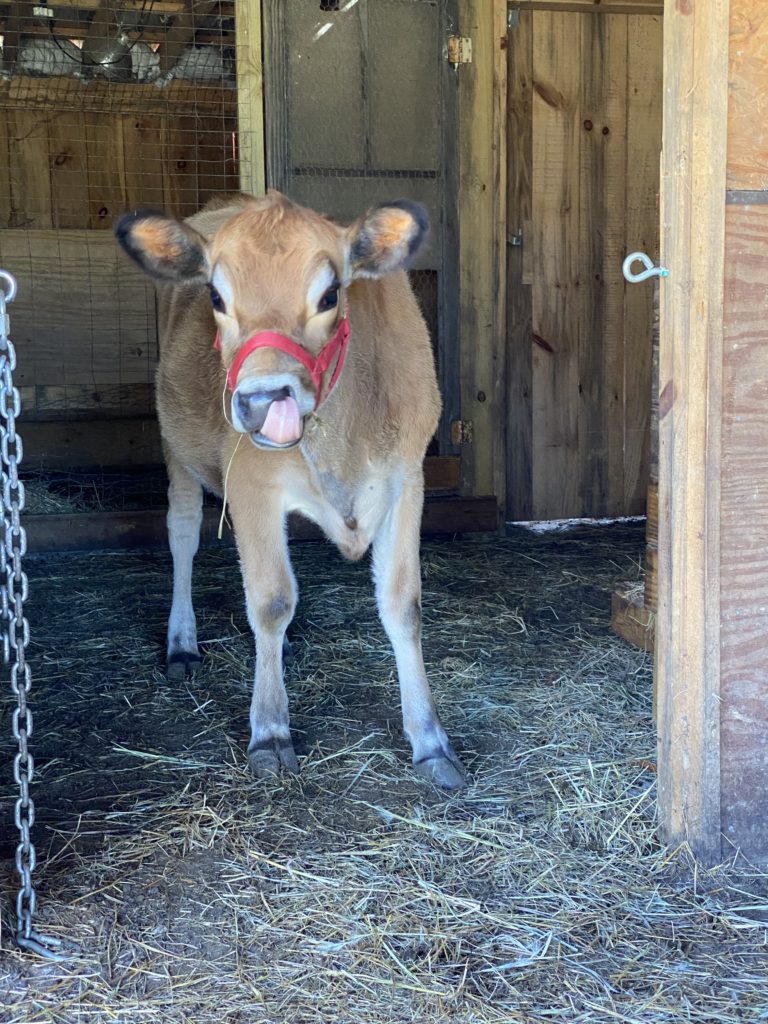
When buying any livestock, a seller who is on the up-and-up will usually be receptive to you requiring disease testing before you bring your new cow home. More than that, the better breeders/sellers of Mini Jerseys will practice annual disease testing themselves for (at a minimum) three of the five recommended tests below (Johne’s, BVD, and BLV).
It is common in cattle sales for you to bear the cost of testing. Because it’s such a hot market, you’ll want to protect yourself before shelling out cash for testing. Get an agreement in writing (via email is fine) that you will pay a deposit on the animal, and that you will pay for the tests you want, and that if the tests prove unsatisfactory, the seller will return your deposit. Then, don’t pay for the tests until you see pictures of official, written results.
Below are listed the five main (and two more optional) tests that your new cow could have before you bring her home (unless—for some—she is a calf, or young heifer who is too young for some tests. In this case, it’s even more important that the whole herd be “tested clean” in the recent past—and that the owner can show you the test results with date and lab name on the results).
- Johne’s: This disease is a tough one. It’s passed in the very early stages of life from an adult cow to her offspring. So, it does no good to test a young calf or heifer for Johne’s. There is no cure for this disease, and if the cow you’re considering isn’t old enough to test, and her mother is not on site, then you’re just going to have to rely on the fact that, at the time of sale, the herd had recently tested clean. You should plan to test all your milk-giving livestock for Johne’s yearly. An animal isn’t truly Johne’s free before seven years old. It is a simple blood test.
- BLV (Bovine Leukosis Virus): Read the details HERE. You do not want to import this into your farm. Again, it’s great to buy from a clean, tested herd, AND you should have the cow you’re buying tested before you bring her home, unless she was among those tested recently in the herd.
- BVD (Bovine Viral Diarrhea): This disease causes infertility in adult cows, which means no calves (or income from them). Read the details HERE. This is another disease that you do’t want to import! There is a vaccine available, as detailed in the linked site.
- TB (Tuberculosis): Many sellers won’t have tested their herd for this because they will say that they are in a TB-free state. However, most states require that the animal be tested for this before being imported into the state, so you can get your seller to test for this if you are paying for other tests. The test is a pain because the vet must come to the cow to inject it with serum, and then return to the farm in three days and check the site for a reaction. Since most areas in America are TB-free, much grumbling can be heard in asking for/administering this test. Smile, and rise above it. It’s good to know that your new animal (and her milk and her calves) is for sure free of TB!
- Brucellosis: A serious disease that can be transmitted to humans, usually via milk. Read the details HERE.
- Q-fever: A widespread disease caused by the bacteria Coxiella burnetii, which is able to infect mammals, birds, reptiles and arthropods. It causes a mild disease in ruminants, but can cause abortions and still births in cattle, sheep and goats. It is also a zoonosis, a disease of animals that can infect humans. Read in more detail HERE.
Some also test for Neospora and Staff A/mastitis panel (if in milk). Do a Google search for both of these.
Yellow-to-Red Flags for you as you interact with sellers include…
- They don’t do even the most basic tests on their herd annually, or they don’t test their whole herd, or they can’t produce proof of the last time they tested their herd. You may decide that the cow you want to buy is worth the testing, if the seller will promise not to sell the cow out from under you while you are waiting for results. Get this agreed in writing!
- They are in a hurry to sell their cow, and aren’t going to allow you to test. The market for good mini Jerseys is very competitive, but the costs of bringing a diseased animal onto your farm can be high. My advice is to walk away; don’t be pressured into the sale!
- The seller pooh poohs the testing process. They minimize the need for testing, making you—the first time buyer—feel small and wrong for requiring it. (Walk away.)
Testing your new cow will take time and money, but the investment with mini cattle is high in the first place, so this is not the thing to economize on! If you import these diseases onto your land, or to infect other animals on your land, you will have made a bad bargain!
About Registries and Registrations
There is a LOT of complex information on this topic, so get a cuppa and tune up your brain!
A newcomer to miniature cattle is often a homesteader with a smaller farm who simply wants a cow to milk. Because Jerseys are renown for creamy, copious milk, a lot of people have heard the name, and when they find out that this classic milker comes in a smaller package with less milk to deal with, and more economies of space, feed, and housing, they are all in. Which is great!
But, before you plunk down your hard earned cash (and there will need to be lots of it) for a mini milker, consider this: it costs the same amount to feed, house, and vet high quality, registered animals as it does to keep unregistered animals. You will need to breed —or “freshen” — your cow every year in order to have milk. Otherwise, she will “dry up.” Here is where registrations and blood lines become important: when you come to sell offspring of your cow, you will get a significantly higher price for a calf that can be registered, is from high quality bloodlines, and is pure Jersey.
To make matters complex, there are (as of this writing) FOUR registries for Mini Jerseys. Frankly, they vary in quality, and a newcomer can find that they’ve been duped by a flimsy piece of paper that means next to nothing to future buyers of their calves. I am seeking to be fair and accurate with my descriptions of these registries; please message me if I am in error of fact. My opinions are my own.
The oldest registry is IMCBR (International Miniature Cattle Breeds Registry)
In 1989 Professor Gradwohl founded the International Miniature Cattle Breeders Society and Registry. The Society now registers a total of twenty-six breeds of miniature cattle worldwide.
As he sold off parcels of land [Professor Gradwohl] became more interested in the application of smaller breeds of cattle to small farms. Twenty years ago he started with Miniature Dexter cattle, Miniature Hereford cattle and Miniature Angus. He also became quite interested in Miniature and Mid Size Highland cattle and smaller Belted Galloway and Dutch Belt animals. From this base he developed a total of eighteen completely new breeds of miniature cattle including the Kentshire®, Kingshire™, Covingtonshire™, Happy Mountain®, American Beltie™, Grad-Wohl™, Barbee™, and Panda™ Miniature Cattle among several others.
http://www.minicattle.com/founder.html
As you can read, Professor Gradwohl pioneered this world of miniature cattle. He established a registry, IMCBR, initially only including cattle that descended from his bulls, but now has a wider membership. With IMCBR, the bar is set amazingly low for entry. You don’t have to prove your pedigree with parental verification. You don’t have to submit pictures or DNA or genetic test results. You just send the information asked for on the application, with a check, and IMCBR sends back a certificate, done on a typewriter. (See fees at the link to the application.)
The heights required (but not verified by any third party) are as follows:
- Midsized Miniature: 43”- 48”
- Miniature: 42” and under
It appears that many of the largest names in the Mini Jersey world use this registry. Among them are Dexter Corner, Sure Shot, Haven’s Heritage, Tumbleweed, Barnyard use IMCBR and AMJA. Many of these sellers have been around the longest in this game, and as changes and challenges to “the way we’ve always done it,” there is controversy.
MY OPINION: Coming from the world of Mini Nubians, where there are two registries, it struck me as odd that this, the oldest one, would not require any objective proofs of the parentage, size, or look of the animal being registered. Nor was Jersey purity an issue, because the creation of miniature cattle was achieved at that time through cross breeding: using smaller sized bulls (from breeds that started small) to bring down the sizes of standard cows. It does not seem to me that there is much value in registering here, since the purpose of registries is to distinguish the blood lines of a specific breed, and I’ve talked to others I trust in this world who say the same.
AMJA&R (American Miniature Jersey Association & Registry)
The American Miniature Jersey Association & Registry was founded in 2000 and has compiled one of the largest data bases of American and Canadian Miniature Jerseys. We are an organization for registering and furthering the Miniature Jersey Breed. We are a Registry for the people and for the betterment of the Miniature Jersey Breed. This Registry is about the preservation of our beloved Miniature cows and those people that have dedicated their lives to breeding them. We welcome new members and encourage you to contact us with any questions you may have about the breed or registering your cows.
https://www.miniaturejerseyassociation.com/welcome-to-amja
This registry asks for more information than the IMCBR on its registration forms. You must send a picture, and are asked to send pedigrees of dam and sire “if applicable.” No blood tests or genetic verifications are required. No proofs of registrations of sire/dam are required, except if you want to register Standard Jerseys with them (🤔).
The height definitions in this registry (also not needing to be verified by any evidence or vet or other independent, third party) are:
- 49” and over is considered a Standard Jersey for downsizing (must include registration)
- 45” – 48” at 3 years qualifies as a Mid-Size Jersey
- 44” and under at 3 years of age qualifies as a Miniature Jersey
MJHB (Miniature Jersey Herdbook & Registry)
Our mission is to grow, preserve, protect and record the lineages and numbers of the 7/8ths pure+ miniature and mid-sized Jersey cattle in the USA as well as Internationally, for future generations.
https://miniaturejerseyherdbook.com/index.php
This registry requires the most information of those listed so far when you are registering your animals. Please read the Rules and Regulations, since there is far more information than I can summarize here, except to say that DNA testing for traits like polled genes and proof of parentage (which is required for registration). MJHB, among others, has an arrangement with Davis labs and thus offers members fiscal discounts. See their fees HERE.
As with AMJA above, height definitions and the registry include the ability to register small standard Jerseys as reference animals in a downsizing program. However, unlike the above registry, you must get a Vet Certified proof of height after the animal turns 3 years old to affirm/retain your registration status.
Your animal must measure under 44” at 3 years to be registered with MJHB. There does not seem to be a distinction between mini and midi animals; your animal qualifies if it’s under the 44” limit at age 3.
PMJS (Purebred Mini Jersey Society and Registry)
Mini Jerseys are first and foremost dairy cattle. So, why are so many of them composites of dairy and beef breeds? Its easy to use American Aberdeen, Galloway, or Dexter to reduce height but it comes at the expense of dairy traits. In over 30 years Mini Jerseys haven’t moved away from crossbreeding. It’s time to look to the future and breed back to proven purity.
The Purebred Mini Jersey Society wants to connect Mini Jersey owners who breed for pure Jersey traits in their Mini Jerseys. Working together we can identify and utilize the purest genetics.
Why another Mini Jersey registry?
I want to teach you how to increase the purity of your Mini Jersey’s offspring, to improve each generation. I’ve been working on this for years within my herd. I started with Midsize pure Jersey cows, carefully selecting small Mini Jersey bulls that I thought would be pure Jersey. Without DNA it was a blind guessing game. By applying the science of Breed Based Representation (BBR) genomics I have produced true, Purebred Mini Jerseys. In time, Purebred Mini Jerseys will be the norm.
This is the future of Mini Jerseys and I want you to be part of it!
https://www.purebredminijersey.com/why-purebred-mini-jerseys.html
PMJS has the highest minimum requirement of all the registries to register. You must get genomic tests completed and show Jersey purity results of BBR85+. (See details about genomic testing and Breed Based Representation below.)
To be registered with PMJS, your animal must have a verified height at 45″ or below at 3 yrs/24″ or less at birth if younger than 3 years. You must submit proof of BD1 negative (the bulldog calf gene) and your animal must meet the published PMJS Breed Standard. Your animal must also have a BBR of at least 85+.
PMJS has distinctions of mini and midi cows. At three years, they must have a verified measurement of 42″ or less for Gold Registration for Minis and 45″ or less for Silver for Midis (wile taking into consideration BBR, too). You an read more detail about registry categories and policies HERE.
At PMJS, the online Mini Jersey database accessable to all Members 24/7. PMJS currently offers personal mentoring and breeding advice. They offer a Waiting List that breeders of Purebred Mini Jerseys can access in order to contact buyers, discounts on DNA testing through Davis labs, and members-only discounts on books and HUGS Calf Jackets. Coming soon, they plan to offer exclusive Purebred Mini Jersey AI Straws.
AJCA (American Jersey Cattle Association)
This is not a registry for Mini Jerseys, per se. Rather, it is a registry for Jersey cows in America.
It is worth double registering your Mini or Midi Jersey cow with this organization because, through them, you can get advanced genomic testing that will aid you in understanding how pure blooded your “short” Jersey is, and also the genetic disposition for a whole host of features. (See Genomic Testing below.)
About Genomics (testing their genes) and Purity
Pure Jersey genetics equals known Jersey traits in a Mini Jersey cow. Mini Jerseys are derived from Jerseys, either by smaller heritage Jersey bloodlines, Jersey crosses, or breeding a Jersey to a Mini Jersey. All these situations include Jersey bloodlines so offspring can be DNA tested for Breed Based Representation (BBR) Jersey percentage.
https://www.purebredminijersey.com/why-purebred-mini-jerseys.html
Here’s a description of that a genomic test means for Jersey purity.
BBR Dairy DNA test. There is currently a BBR test available for 5 dairy breeds; Ayrshire (AY), Brown Swiss (BS), Guernsey (GU), Holstein (HO) and Jersey (JE). The Council of Dairy Cattle Breeding (CDCB) owns these proprietary BBR tests. They had them developed to assess the degree to which alleles in one individual dairy animal’s genome are in common with the allele frequency of any of the 5 reference breed groups. CDCB made the decision that animals with a BBR score of greater than or equal to 94 for 1 of the 5 testing dairy breeds are considered to have one-breed background and will be categorized as 100% for that breed, and other possible breed percentages will be set to zero. BBRs below 94 are reported at the % calculated. Precise percentages of breed sources are not possible because of genetic variations that exist within the same breed. And although there are common alleles within breeds, there are also common alleles across breeds. The genetic contribution from a primary breed could be off by 5% or even more. If any breeds other than those 5 are part of the animal’s ancestry then the BBR crossbred test will not be accurate. A BBR score of lower than 90 however, usually indicates crossbreeding. (~ CDCB tools for the improvement of the Jersey breed, 06-2018, worldjerseycattle.com.) The CDCB BBR DNA test is available to the public, at the time of this report, costing owners approximately $25 /cow, $135 /young bull, or close to $1600 /bull over 14 mos.
http://www.miniature-cattle.com/article.bbr.htm
Below is the Genomic report of my cow, Emma, done through AJCA (listed above) as required by the PMJS registry.
In the top right chart, you can see that her BBR (Breed Based Representation) is 93. If it had been 94+, it would have been rounded to 100. As it is, if I breed her to any bull with a higher than BBR94, she will produce BBR100 offspring. Only this tests offers any measure of how pure are the Jersey genetics in Emma’s makeup. (You can read more about this test for purity and what it means HERE.)
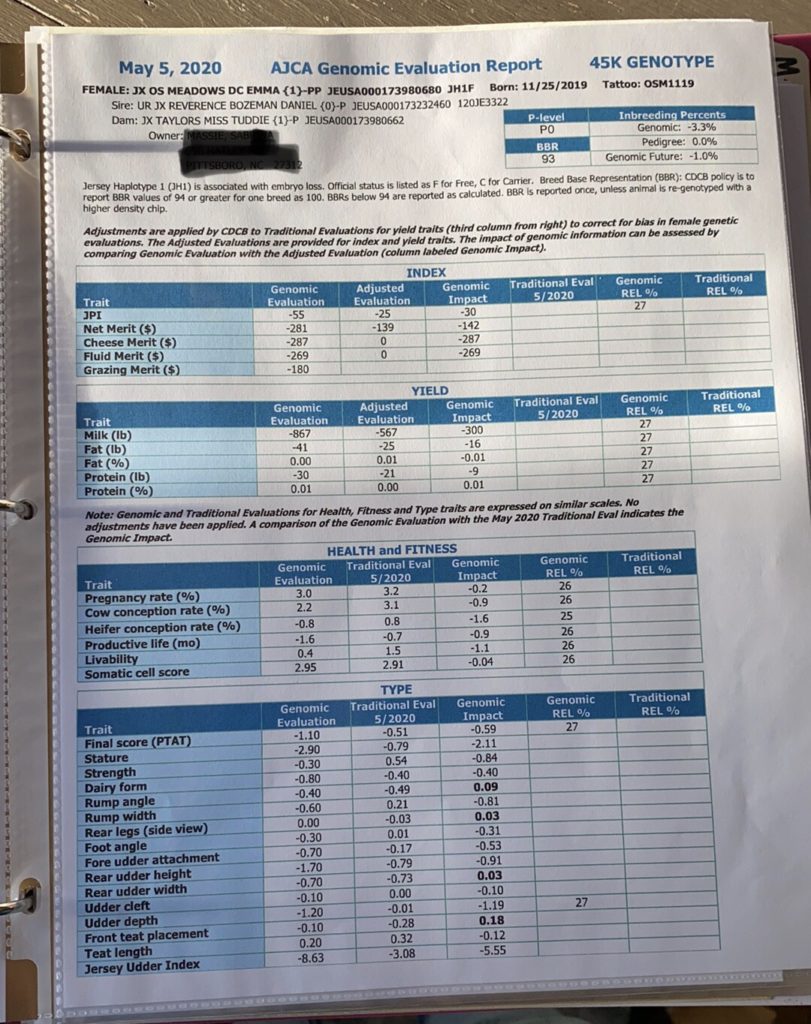
For a newbie to the Mini Jersey world (and/or the world of cattle) these test results can be hard to understand. A key to them is to understand that AJCA offers these tests as a service to their much wider membership of standard Jersey owners. Thus, all these tests compare Mini Jerseys to standard ones. Standard Jerseys will give more milk, stand taller, be more robust, etc. Thus, for now, many of the traits profiled yield negative numbers.
The hope is that, through the PMJS registry, enough data can be collected to make these tests meaningful for our minis by way of comparison.
This hope is already being fulfilled. In looking at these results before I purchased Emma, I was able to see that she would be a good milker, with many correct elements of conformation, and see where her weaknesses lie.
I then looked at the genomic tests for bulls whose semen is offered for AI in order to choose one who would probably improve areas in offspring where she’s lacking. This is the goal of all responsible breeding: to better the breed through intelligent selections!
As stated above, dairymen have been using genomic testing for years in this way in order to improve the overall health and milk production for dairies and meat production for beef cattle in their herds. Now, we are harnessing the power of science to work towards eliminating non-Jersey strains in our miniature cattle so that we can have the qualities so loved in Jersey cows for centuries in our minis: namely creamy, delicious milk in copious quantities from beautiful, correctly conformed, gentle cows.
About Breeding and Bulls
In order to have milk, you will need to breed your cow yearly. So, before you purchase a cow (even in milk) or heifer, answer for yourself this question: “How will I breed her in the future?”
Keeping bulls can be challenging. They are far less trustworthy than cows in terms of handling and sudden aggression. For whatever reason, when first shopping for cows, I heard a lot about how dangerous Jersey bulls are — they are notoriously some of the most aggressive among breeds. And though sellers may claim that their bull is as gentle as a kitten, and show pictures of their children leading him, beware: it is often the so-called “gentle bull” that ends up injuring farmers.
Many who keep bulls for breeding purposes keep them only until they turn two, because younger bulls are generally more manageable (or gentle). They then sell or slaughter them. Ask for proof of the age of any bull you contemplate purchasing. Also ask for pictures of its sire’s dam, and of course, registration papers (and indeed all of the questions asked below in the next section that apply).
To keep a bull, you will need strong fences, and probably some electric fencing as well. This is especially true if you have neighbors with cows or heifers in the next field to yours. A bull not kept with cows should have a buddy: another bull or a steer (castrated bull).
The other route to go when seeking to breed your cow is artificial insemiation (AI).
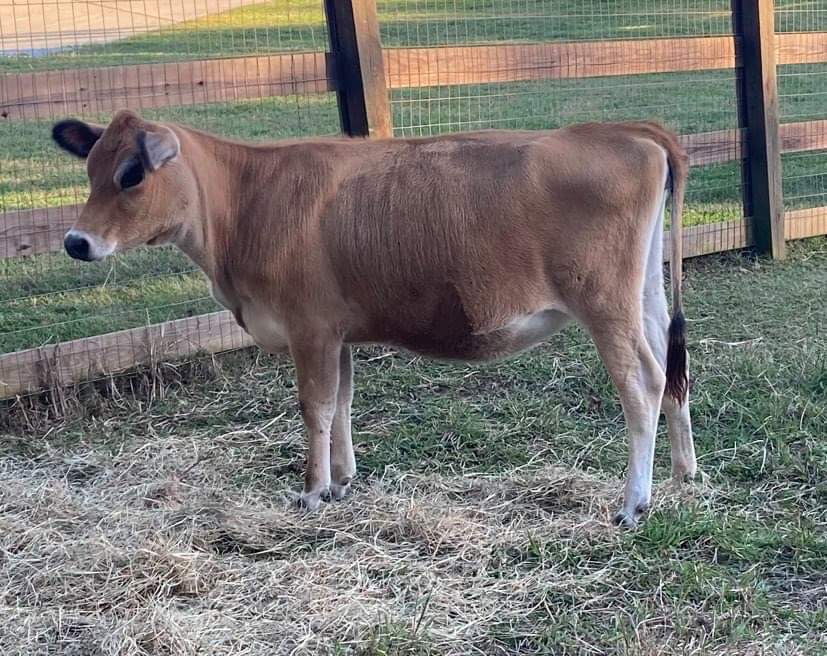
You will need to find an AI tech — who may be a vet in your area, or affiliated with the larger semen sellers, such as Select Sires or Bovine Elite. We chose to go this route with our first cow because the challenges of keeping a bull seemed too many for us. It was very difficult to find an AI tech who would come to our remote mountain farm for one cow, but a tech affiliated with Select Sires was willing to come. I had to make a lot of calls before I got into contact with him, but I made sure to have that settled before I purchased my first heifer.
As far as purchasing bull semen for AI, there are quite a few people selling semen. Google “Mini Jersey semen for sale” and you will come up with a variety of choices. In selecting a bull, many factors go into making a good choice, which is beyond the scope of this page.
A knowledgeable mentor can help; just be aware that if you choose to be mentored by someone selling bull semen, they may be biased. And do remember that the future of the dairy world (and therefore the marketability of your calves-to-be) lies with A2/A2 offspring who are smaller than 44” at three years and have solid udders that perform over years.
Two kinds of bull semen are generally offered:
- Conventional semen: cheaper, and you have a 50/50 shot at a male/female calf. Prices I’ve seen for quality, A2/A2 polled bulls at this writing are between $45 and $70/straw.
- Sexed semen: believe it or not, semen can be sexed, and female sexed semen offers a 95% chance that you will have a heifer calf. Sexed semen also has overall lower potency and every straw that I’ve seen listed was $240/straw, unless you’re buying in bulk—5 straws were only $200 apiece!
When doing AI, there is always the possibility that the first attempt won’t “take.” So, one needs to buy more than one straw per breeding to be safe. The straws are stored in a “tank” that is cooled with liquid nitrogen. Typically, you can have your semen shipped to your AI tech directly, and s/he will store it for you until the insemination. Semen keeps indefinitely as long as the tank is properly maintained.
Cows come into heat about once a month, and another challenge that the new cow owner faces is learning to recognize the heats, especially if there is no bull present, or if you only have one cow. In some cases, you may need to regulate your cow’s heat with drugs because the window for successful breeding is about 12 hours, and your AI tech may not want to make the trip for one cow; thus s/he may require you to “sequence” the heat so that the trip to your farm may be planned in advance. Your veterinarian will best help you navigate this hurtle.
A few other things to plan for…
In summary, there’s a lot to be considered when buying a cow, even if she’s in milk. She will need to be bred again before a year or two are out, if you’re going to continue to milk her. Be sure to think this breeding aspect through before you purchase her. In doing this, you’ll also need to be sure that you have a local cow veterinarian to call on.
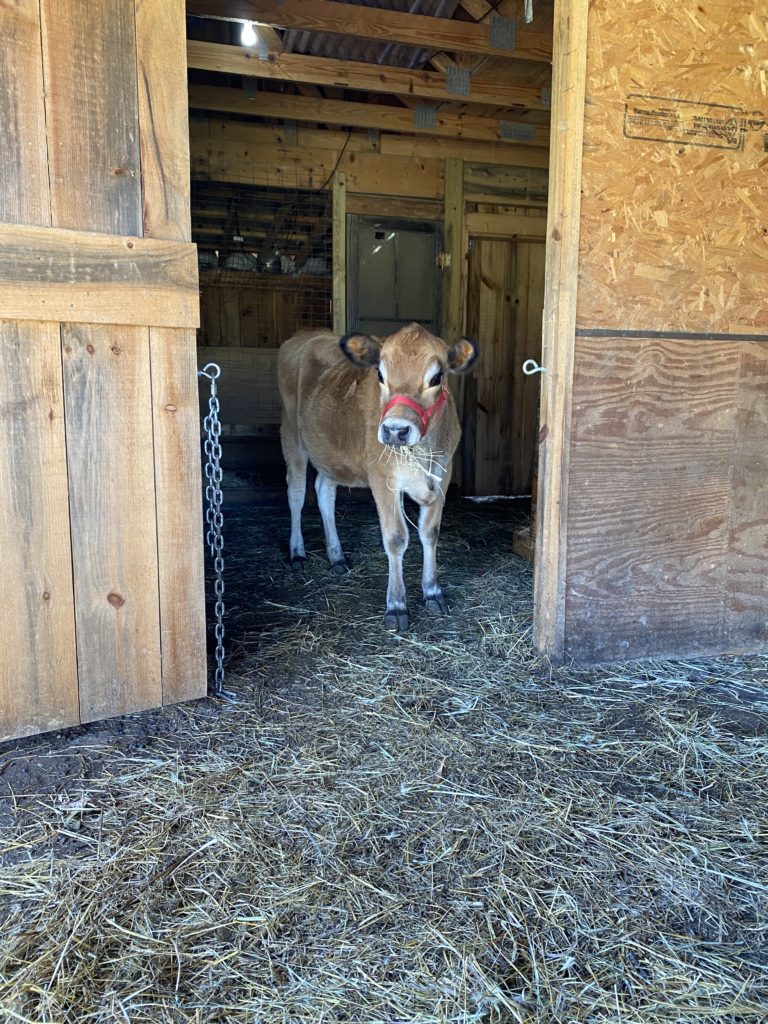
Also consider her living conditions: she’ll need shelter. In most areas, a run-in shed is the minimal shelter. She needs to be able to get out of the wind and snow. However, consider how you’ll shelter winter calves and also where you’ll plan to milk and/or doctor her.
In terms of food: she’ll need adequate pasture, good hay in winters, other feeds when lactating, and mineral supplements. You can find the specifics for these things online. Different areas of the country offer different types of forage, hay, etc. Join a group or forum online to learn more about how to feed your cow, ideally before you bring her home. A book that I thoroughly enjoyed reading is Keeping A Family Cow by Joann S. Grohman. Find it on Amazon.
Your cow should also have herd mates of some kind. When we bought our first Mini Jersey, we did not have other cows, but we did have goats. They shared the same field and shelter until such time as we could either breed her or find another cow to buy. This was not ideal, but it was better than her being alone.
You should plan to be around and interacting with your cow daily. Cows can grow skittish and wary of people in general if they are not regularly worked with. You’re going to want a cow who is easily caught and led to be able to milk and vet her (and to AI breed her).
Questions to Ask When Buying a Mini Jersey
You are about to make a major purchase in a hot market. It’s tempting to bow to the pressures of the market and end up with less animal and more headaches than you bargained for, so take your time. A worthy seller will know that all of the questions below prove that you are careful and will be a good caretaker of valuable animals.
- How old is the animal?
- How long has seller had the animal?
- If born on the farm, pictures of parents? Especially dam’s udder and, if possible, sire’s dam’s udder.
- What kind of disease testing is regularly done on the herd, and how often? Please send pictures of most recent test results. (If not, why not?) Has the herd been closed to new animals? For how long? (Closed herds still need yearly testing done for those diseases — like Johne’s — that take years to show up.
BUYER BEWARE: Reputable sellers will test before selling upon request. You many have to share (or bear all the) costs of tests. But don’t bring an untested animal home! And, to add to the mix, results can be forged. This has gotten to be such a problem that UC Davis labs now offer free verification services of test results! - What are the milk stats: A1/A2? Kappa casein? Beta Lactoglobulin? If in milk, amount she’s giving per milking? With or without a calf on her? (If a heifer, does the seller know what her dam’s production was?)
- Is the animal horned, disbudded, polled (hertozygously or homozygously)? Proof of genetic testing for polled genes?
- Are parents registered? Which registry? Pictures of registrations, please?
BUYER BEWARE: See above registry descriptions to discern how much that registration is actually worth to you! - Any genomic testing done? Pictures of results, if so? What is his/her BBR? (100 is perfect; higher is better—see above)
- Video of the cow walking on a lead line? Look at how the cow moves, overall conformation, height compared to the seller, and tameness. How easily is the animal handled? Does it shy away from the seller? How is the conformation?
BUYER BEWARE: If you’re going to milk, vet, or interact with a cow, you’re going to need to be able to lead it. If the cow or bull is unused to halters and leads, think twice about getting it if you’re a newbie. - Ask for a height measurement. Ideally, a clear picture of the cow with a measuring tape or stick, but this is impossible without a helper, and some sellers just won’t have one. Measurement is take from the ground to the hip. Cows grow for three years before they reach their finished height. Consult the diagram above for true categories of miniature cattle. Smaller cows are more expensive, all other factors being equal, because it takes years to “breed down.” One good idea is to ask for a picture (or better, a video) of the cow next to an item of known height, like a calf panel.
- Ask to see pictures of the dam’s udder and sire’s dam’s udder. Parental udders are surprisingly consistent, genetically speaking, and seeing these pictures gives you a good idea of how your heifer’s udder will look.
- Ask if the animal has had any health problems.
- If you’re going to transport across state lines, discuss who will pay for the necessary health certificate.
- Who will pay for transport (usually the buyer) and how will it be accomplished? BUYER BEWARE: Always get a recommendation for a commercial transporter from someone who has used the service There are many nightmare stories of animal transports gone wrong, with transporters being either irresponsible or downright shady.
- If you are new to miniature cattle, you may want to ask around about the seller. It’s a small community, and most breeders have a reputation, good or bad. Be aware, though, that different people may have varying opinions of the seller, so it’s good to get more than one opinion.